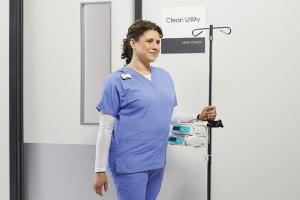Nurse communication systems make strides

Nurse communication systems continue to evolve for hospitals, as they interface with medical equipment, real-time locating systems (RTLSs) and other Internet of Things-enabled devices. They continue to improve communications, receiving and delivering information that is crucial to enhancing hospital operations and patient care. Still, vendors face some challenges.
The most important issue for nurse communication systems is lessening the load on clinical staff so they can spend more quality time caring for patients, according to Lee Clark, president and CEO at Care Analysis, Nashville, Tenn.
He notes that health care facilities have too many devices and systems that don’t work well together. In addition, security and reliability are important considerations that impact ease of use. “As vendors, we must view all health care facilities as slight variations to the same use case,” Clark says. “This will become more important as providers use more remote services and contingent staff.”
The big issue is that many of today’s communications solutions are siloed or not available to the care team when and where they need it, says Marc Peters, chief executive officer at West-Com Nurse Call Systems Inc., Fairfield, Calif. “Having a better understanding of the where, what, why, how and for who is vital to improving situations,” he says. “Also, understanding that nurse communication really involves the entire care team and departments such as dietary, pharmacy, case management, transportation, lab and imaging.”
Ultimately, nurse call technology solutions should make the lives of clinicians easier. Nurses do not have time to figure out who is on call or sift through paper lists to find phone numbers, says Rhonda Collins, chief nursing officer at Vocera, San Jose, Calif. “The ideal communication system is a voice-activated one that enables nurses to connect with the right person or team quickly and easily, simply by saying a role or group name, such as, ‘Call respiratory therapist.’”
Increased integration
The current trend is to integrate even more medical devices to nurse call systems. Using a required platform like a nurse call that’s already in place makes more sense than adding a separate platform or infrastructure to collect data and distribute alarms.
“However, questions around integration with various systems has become a talking point with most customers,” says Jeff McCormick, director of product management at Ascom Americas, Morrisville, N.C. “One concerning trend is the emergence of nonregulated products with menus that allow patients to send messages to caregivers. While these nonregulated systems provide many benefits, if used by a patient in an emergency, it may result in bad outcomes.”
Receiving and delivering information that is used to communicate with hospital staff members, patients and family members is critical to improving patient safety and the overall care experience, experts agree. Proper integration of systems is important.
When all communication goes through an integrated platform, the system knows the number of calls, texts, alerts and notifications each team member has received within a certain time frame, according to Collins, so the system can redirect the next communication to a clinician who is available. “If a nurse is responding to a Code Blue, for example, they should not receive calls, messages, alerts or alarms until the code is completed. An integrated communication system helps reduce alarm fatigue, speed up staff response times, and improve patient care, safety and experience.”
Myles Cochran, director of marketing at Jeron Electronic Systems Inc., Niles, Ill., says nurse call systems are the central information hub of all patient and staff interactions, which includes staff location and medical equipment alarms. “Our ‘Provider’ system can integrate with RTLSs by logging and alerting all parties of automatic staff registration in and out of patient rooms, automatic cancellation of service requests, and locating staff by level and name from any nurse console,” he says. “Medical devices also alarm through nurse call.”
Integration is clearly the direction in which these technologies are evolving, says Mike Abcunas, senior solutions manager for senior living at Stanley Healthcare, Portsmouth, N.H. “For our senior living solution, we integrate a wide range of other systems (e.g., fall prevention, wander management and fire safety), giving senior communities a single place to manage all kinds of alerts. From the other side of the equation in the hospital space, integration of our RTLS platform is a common use case to automate call response.”
Hillrom, Chicago, has launched cloud-based Hillrom Smart Device Connectivity in partnership with Microsoft Azure. It connects real-time data coming off smart beds and vital signs streaming from other monitoring systems, and displays patient vitals in nearly real time. Through patient risk surveillance, the system can send alerts to caregivers detailing a patient’s condition before it becomes critical, the company states.
Smartphone connections
Nurse communication systems are being adapted for use with smartphones and other hand-held devices. This allows systems to reduce or eliminate alarm fatigue as well as patient and staff bottlenecks.
West-Com’s nurse communication systems have supported smartphones and other hand-held devices for more than a decade, according to Peters. “The question is, what applications are the smart or mobile devices using, and how do they handle incoming messages and events? Many hospitals have focused primarily on clinical applications instead of nurse and patient communication,” Peters says. “This can lead to poor patient care experiences, alarm fatigue and workflow inefficiencies.”
West-Com recently developed a mobile application to address these issues that can be used in conjunction with other mobile applications. The application, MobileCare, is designed to reduce the number of patient calls and events that occur during a nurse’s shift, so they have more time to spend with their patients.
Erik Roehl, vice president of global strategic marketing at CenTrak, Newtown, Pa., says many forward-thinking hospital administrators are incorporating locating technology and hand-held devices into nurse communication systems.
“CenTrak’s nurse call automation solution eliminates manual functions such as call cancellation, so nurses can focus on patient care,” Roehl says. “It also offers interoperability with mobile devices to enable real-time communication between staff as well as integrations with patient engagement platforms, access control systems, security cameras and electronic health record (EHR) software.”
As cellular phones become smarter, they enable caregivers to utilize a single device to accomplish various health care tasks, which include collaborating with care team members and accessing EHRs, which improves workflow.
“It is important that any integration deployment is planned carefully to avoid creating alarm fatigue,” McCormick says. “Ascom Americas enables smartphones such as the Ascom Myco 3 to do more than traditional systems. I refer to a smartphone connected to Ascom’s nurse call Telligence system as a cordless staff console.”
Incorporated features
Nurse communication systems recently introduced to the health care market incorporate many of the above-mentioned features.
CenTrak has launched several solutions to support hospital staff. “The same smart badge that automates call cancellation enables nurses to discretely call for help, from wherever they are, the moment they need it,” Roehl says. “Because the system knows their exact location, team members and security personnel can locate them and quickly provide support.”
Hillrom has introduced the Voalte Experience App, a patient engagement iPad application that integrates with the Voalte nurse call system. This bedside app allows patients to participate more directly in their care and tighten communication with caregivers.
“We’ve updated the Voalte Nurse Call system, modernizing the look and feel of end-user devices such as the staff console and patient room station,” says Trey Lauderdale, vice president and general manager. “Hillrom also has added functionality and processing power to the hardware. This lays the foundation for further enhancements, such as device-to-device video calling.”
Jeron Electronic Systems has introduced the Provider 700 nurse call system, which supports patients and staff with alerting, communication and workflow options, creating a customized solution to meet the requirements and budgets of a variety of facilities. “The system supports a facilitywide solution for wireless alerting and communication, RTLS, one-touch workflow, real-time dashboard displays and activity reporting,” Cochran says. “These features easily scale to any size facility or campus.”
Vocera offers the Vocera Smartbadge, a wearable communication device that enables clinician agility and improves patient care. It addresses clinicians’ needs for hands-free communication, secure messaging, and alert and alarm management.
“This voice-controlled device allows clinicians to connect with the right person or group via simple voice commands,” Collins says. “A touchscreen enables them to receive notifications with patient-centric information and prioritized tasks. For example, a nurse who receives a sepsis alert can quickly see the patient’s room number, name, age and vital signs without having to log into the EHR.”
Care Analysis has reengineered its nurse communication platform to work across many health information systems, making it easier for users to make data-driven decisions without IT development. Users range from hospital operators to front-line managers to clinical staff. “In addition to the analytical platform, we have enhanced our middleware to handle nurse assignments, alarm management, escalations, and messaging across many nurse call and other critical systems,” Clark says.
Cornell Communications Inc., Milwaukee, offers the “inform” activity management platform. Featuring smart handset capabilities, it can track responses by each staff member, the time spent with each patient and the reason for the visit. Data is logged and posted in real time to help assess staff performance and the needs of residents.
“Voice communication from care staff to residents is now being tested in senior care facilities because this feature disappeared when wireless devices replaced wired intercoms in retirement homes,” says J.J. Johnson, CEO at Cornell. “The next feature will be calendar management to schedule and monitor the many planned activities in senior care. It will allow facilities managers to better coordinate therapy sessions, bathing schedules, on-site and off-site doctor’s appointments, and related transportation issues.”
Stanley Healthcare recently launched a new version of the core software for its Arial nurse call/emergency call solution. It features expanded integrations to core resident safety solutions, including predictive fall reduction. The updated mobile app provides more actionable insights to caregivers and improves support team collaboration via in-app voice communication. “The goal is to continually adapt to evolving facility needs and deliver a solution that works for any type of operator in the senior living space,” Abcunas says.
TekTone Healthcare Communications, Franklin, N.C., has introduced the Tek-CARE400 P5+ nurse call system, which provides options for reporting, third-party integration, wander management and mobile notifications via the Tek-CARE Staff App for iOS and Android. “Calls can be received and answered from any mobile device on the network to ensure that staff knows when and where help is needed, even when juggling multiple tasks,” says Brad Hyder, director of marketing. “Capabilities include full duplex audio, voice-enabled apps and staff messaging.”
Continued evolution
Looking ahead, nurse communication systems will continue to evolve as an enterprise health care communication platform, Peters predicts.
“They will expand to provide communication and reporting beyond a single facility,” he says. “Soon, cameras will be installed in patient rooms to improve communication and collaboration, and to provide patients in rural facilities with access to specialty providers.”
Neal Lorenzi is a freelance writer and regular contributor based in Mundelein, Ill.
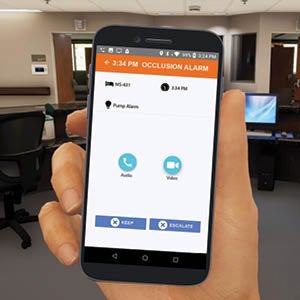
MULTITASKER
The MobileCare application actively manages the care team’s patient communications and provides direct-to-caregiver nurse call alerts, staff assignments and virtual rounding. West-Com Nurse Call Systems Inc.
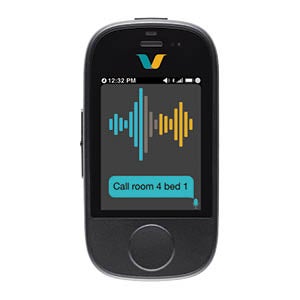
TEAMWORK
The Vocera Smartbadge is a hands-free, voice-controlled wearable that helps care teams communicate and collaborate. Vocera
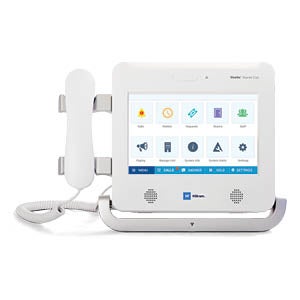
SLEEK AND EFFICIENT
The Voalte nurse call system features a modernized look, upgraded processing power and a video camera added to the staff console. Hillrom
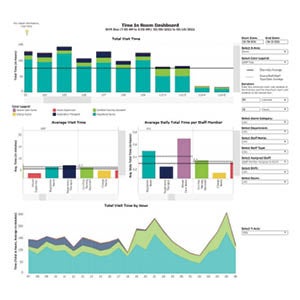
IMPROVING EFFICIENCY
This system features a time-in-room dashboard that provides detailed analysis of patient needs and caregiver activity, helping to improve staff efficiency and patient satisfaction. Care Analysis

SMART PERFORMANCE
These smart badges automatically cancel patient alerts when a caregiver enters the patient’s room. CenTrak
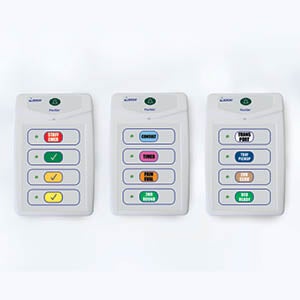
INFORMATION FLOW
The Provider 700 nurse call system streamlines alerting, activity logging and workflow between caregivers, residents and patients. Jeron Electronic Systems Inc.

KEEPING INFORMED
The “inform” handset simplifies resident care by communicating which staff are addressing resident needs and logging why the individual needs assistance. Cornell Communications Inc.
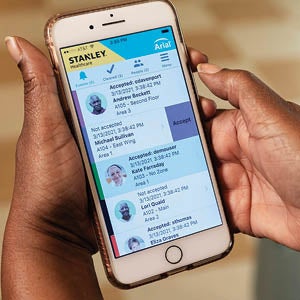
ON ALERT
The Arial mobile application puts alert information into the hands of caregivers and supports coordinated response. Stanley Healthcare
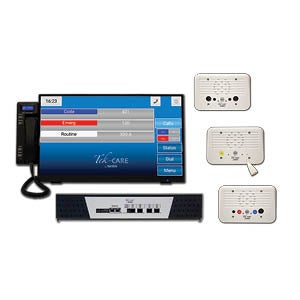
THOROUGHLY MODERN
The Tek-CARE400 P5+ features modern aesthetics and is both staff- and patient-friendly. TekTone Healthcare Communications
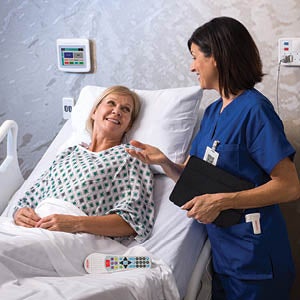
CHECKING IN
The Telligence patient response system gives clinicians a comprehensive view of the patient’s status. Ascom Americas
Neal Lorenzi is a Mundelein, Ill.-based contributor to Health Facilities Management.




